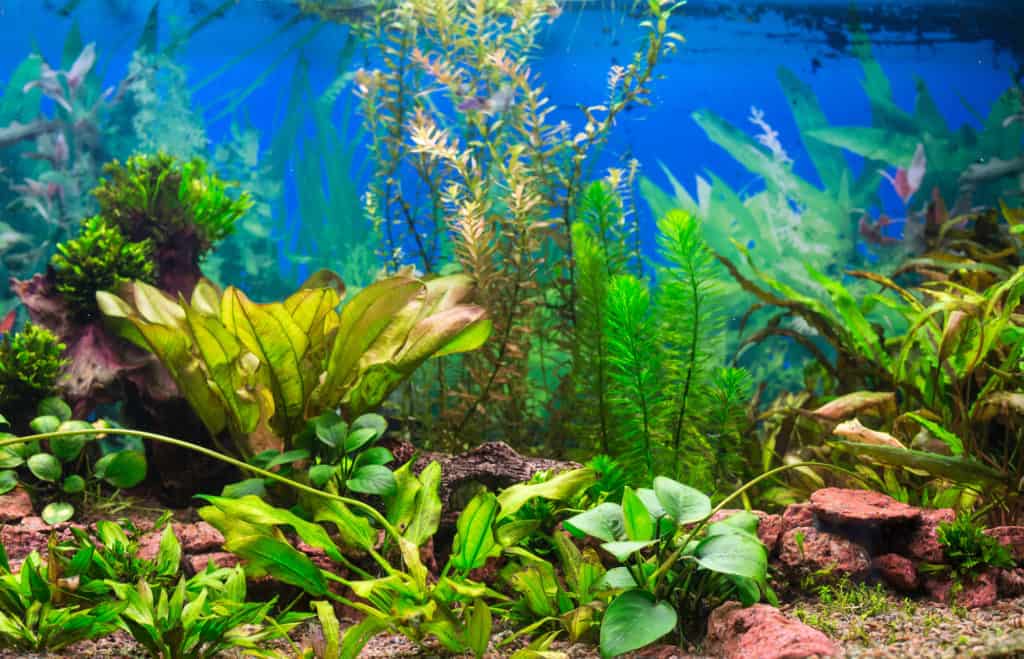
Nitrate is a harmful chemical which prevents you from maintaining a healthy lifecycle for your aquarium fish.
Excess nitrates may not directly kill your fish, but they stress the fish, making them susceptible to diseases.
Nitrogen comes from many different sources, including fish waste, dirty filters, uneaten fish food, or decaying plants.
One of the most common ways of getting nitrate levels under control is to use aquatic plants.
Some plants are highly effective in utilizing nitrate and have the added benefit of producing oxygen.
Read on to discover 10 of the best aquarium plants to help you fight nitrates.
Top 10 Best Aquarium Plants to Reduce Nitrates

Here’s a list of the top 10 aquarium plants that effectively absorb nitrates.
1. Moss Balls
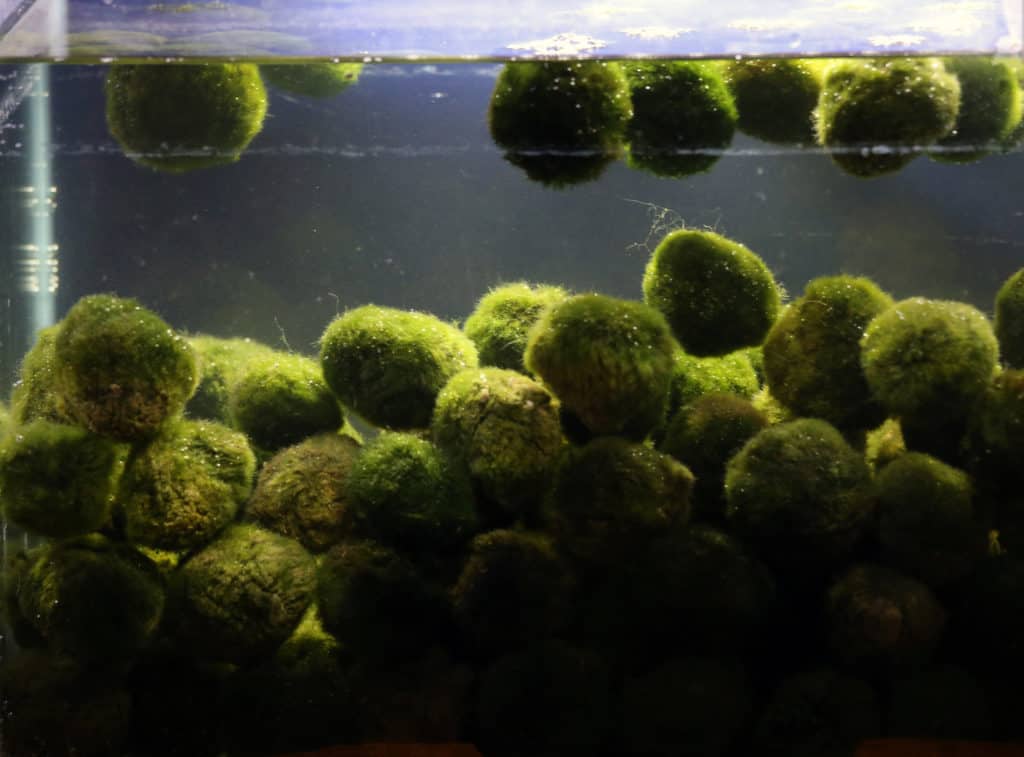
These fuzzy little balls add to the beauty of your aquarium by sitting on the floor of the fish tank.
These low-maintenance plants are incredibly popular among aquarists for their many benefits.
Technically, moss balls aren’t plants.
They’re a kind of algae.
You can rely on them as powerful natural filters that look cool and don’t need much care.
These column feeders absorb nitrates from the aquarium and release oxygen.
Nitrate isn’t the only chemical these cute furry balls process.
They suck up other chemicals like nitrites and ammonia as well.
Plus, small fish can use these cozy balls as resting spots.
The best thing about moss balls is that you don’t need to prune them because they don’t grow that fast.
That’s a big advantage since the plant won’t outgrow the fish tank.
They’re hardy plants with a high tolerance for salt in the water, and other changes in the tank conditions won’t affect or kill them either.
Plus, they don’t contain any pesticides or harmful chemicals, making them a healthy companion for your fish.
There’s a catch with moss balls, though.
Big fish such as koi are known to eat them!
Remember to throw the moss balls out after a few months because they absorb nitrates until they get saturated.
2. Java Fern
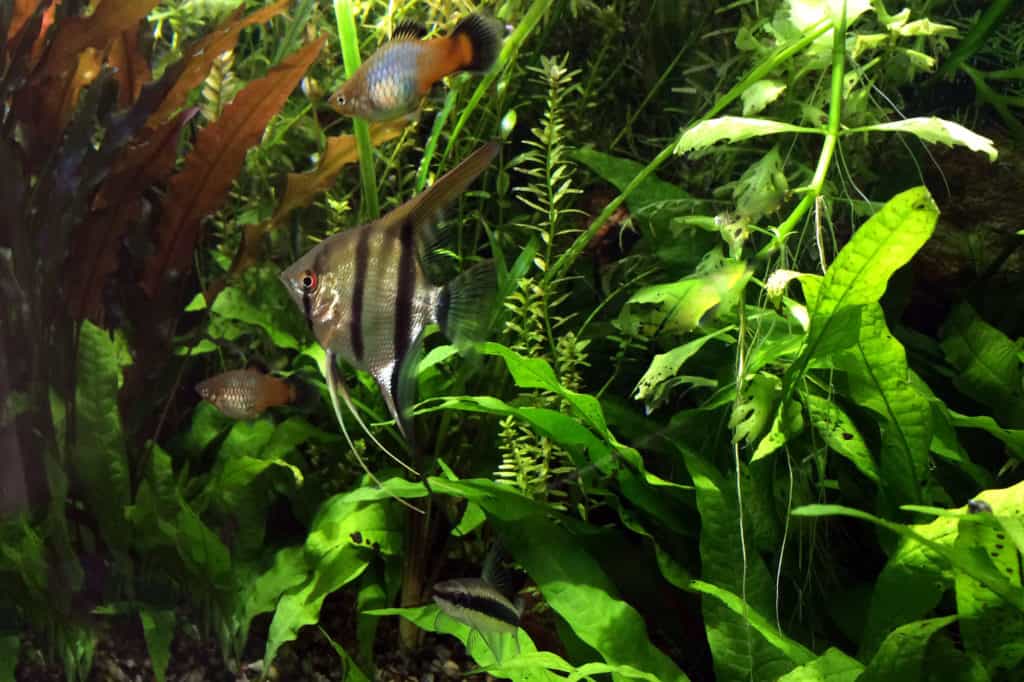
Java fern is another popular aquarium plant which acts both as a decorative plant and one that helps maintain your fish’s health.
It has two parts: leaves and rhizome.
It has no real roots, so it attaches itself to surfaces through its dark brown strings and the rhizomes that work as anchors.
Also, it has a low growth pattern which allows you to attach it to driftwood or rock.
Java fern is extremely hardy and low-maintenance and grows well without much light, nutrients, or substrate.
If you’re a beginner, it’s the perfect plant!
Given its slow growth, it doesn’t absorb much of the nutrients in the tank.
It feeds on nitrates and phosphate, so it’s a perfect plant for maintaining nitrates at a healthy level for your fish.
Another advantage of java fern is that herbivorous fish can’t eat it easily thanks to its tough and leathery leaves.
Plus, they don’t seem to like this plant’s taste.
There are different varieties of java fern, under the scientific name, Microsorum Pteropus.
They include the narrow leaf, trident, and needle leaf, which effectively absorb nitrates from the water column.
3. Water Hyacinth

Also known as Eichhornia Crassipes, water hyacinth is native to Brazil, but it has spread worldwide as a popular aquarium plant that helps keep the water clean and clear.
It’s a floater with stems containing fleshy parts as big as a softball.
Water hyacinth produces beautiful purple flowers that last for one day.
Interestingly, it doesn’t stay in one spot and is always on the move.
Plus, it doesn’t need much attention and grows fast.
You can have high-quality, low-nitrate, and beautiful water in your tank with these plants.
Its fine roots are long and network-like and can be one foot long.
These roots absorb nitrates from the water, making them an essential component of any aquarium to keep nitrate levels as low as possible.
The pendulous roots of the water hyacinth are favorite nibbling items for fish like koi.
However, you should keep fish from chewing off the roots because it can affect the plant’s ability to absorb nitrates.
When you see the roots look weak or chopped off, you can move the water hyacinth to another container and add fish emulsion to it.
Its fast-growing roots begin to recover soon, and you can return it to the tank to keep nitrate levels down.
4. Hornwort
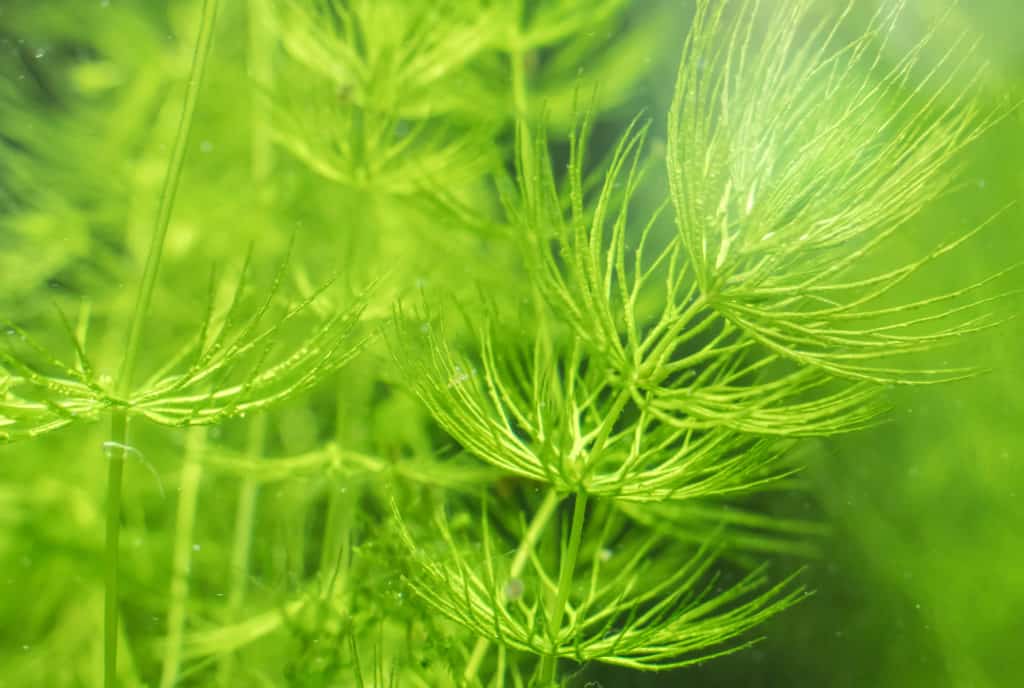
Like most nitrate-filtering plants, hornwort is a fast grower.
The nitrate in the tank works as a fertilizer to fuel this growth, which is awesome in terms of keeping the water clean.
It’s mainly a floater, but sometimes it can attach to the substrate.
It has needle-like leaves that feed off the water column and can grow up to 14 feet.
Due to its appearance, it also goes by the names of foxtail and coontail.
Most fish can’t eat this plant because of the pointy and stiff needles on the leaves.
This means you can rest assured fish won’t destroy the plant by chopping off the leaves.
However, fish, shrimps, and fry love it as a hiding place.
They do use it as a source of food.
The biofilm that grows on hornwort gives young fish an excellent source of food.
Since hornwort can eat up nutrients very quickly, you should always check for nutrients and add liquid fertilizers so that it doesn’t starve the other plants in the aquarium.
However, it can make the fish tank messy by constantly shedding needles, so make sure to clean the water regularly.
Also, it needs regular pruning if you want to keep it neat.
5. Water Weeds
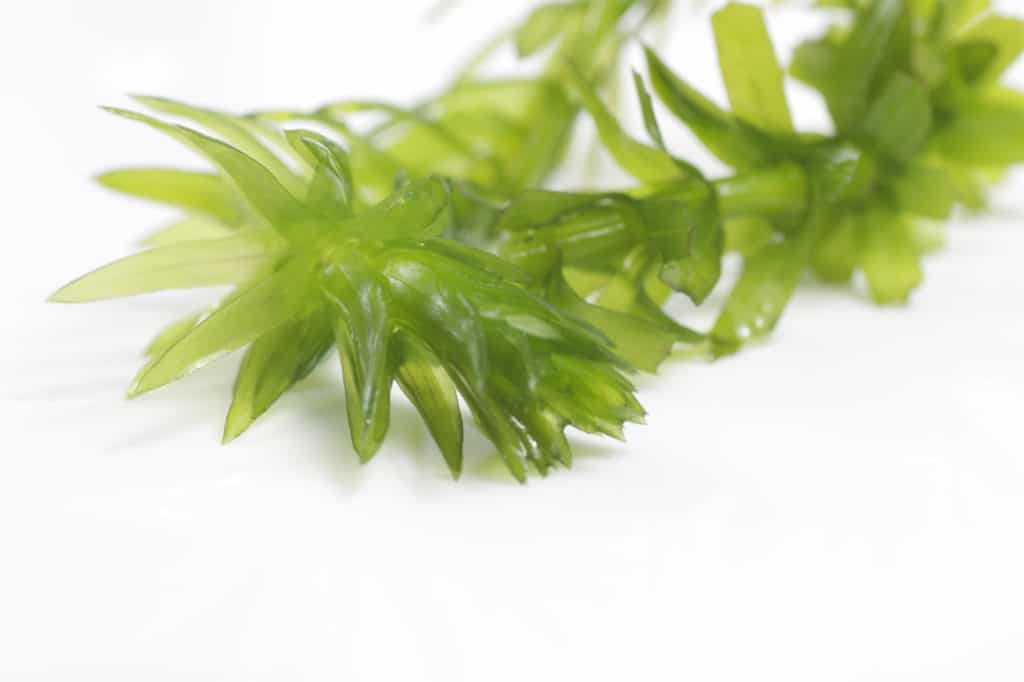
Water Weeds or Anacharis Elodea is another hardy plant that works as a natural filter.
It easily uses up excess nutrients, harmful chemicals, and nitrates and is an excellent oxygenator.
It has tiny branches that can grow into new plants.
They grow stems in all directions to absorb nutrients from the water, including nitrates.
While growing fast is great in terms of nitrate cleaning, it can shed many leaves, which means you need to change the water frequently to avoid the mess.
Since the plant grows very tall, it’s better to put it in the foreground or mid-ground.
The best thing about Anacharis is that it doesn’t need many nutrients, light, or maintenance.
If you’re a beginner, you’ll be fine with this filtering plant as long as you make sure it doesn’t get messy.
This useful and beautiful plant provides shade and places for laying eggs for the inhabitants of the tank.
They also serve as food sources for apple snails, goldfish, and cichlids.
By eating up all the nutrients in the water column, it can starve algae, cleaning up the water surface.
It also acts as a physical filter, trapping debris and dirt and keeping them from getting into the substrate.
6. Eelgrass
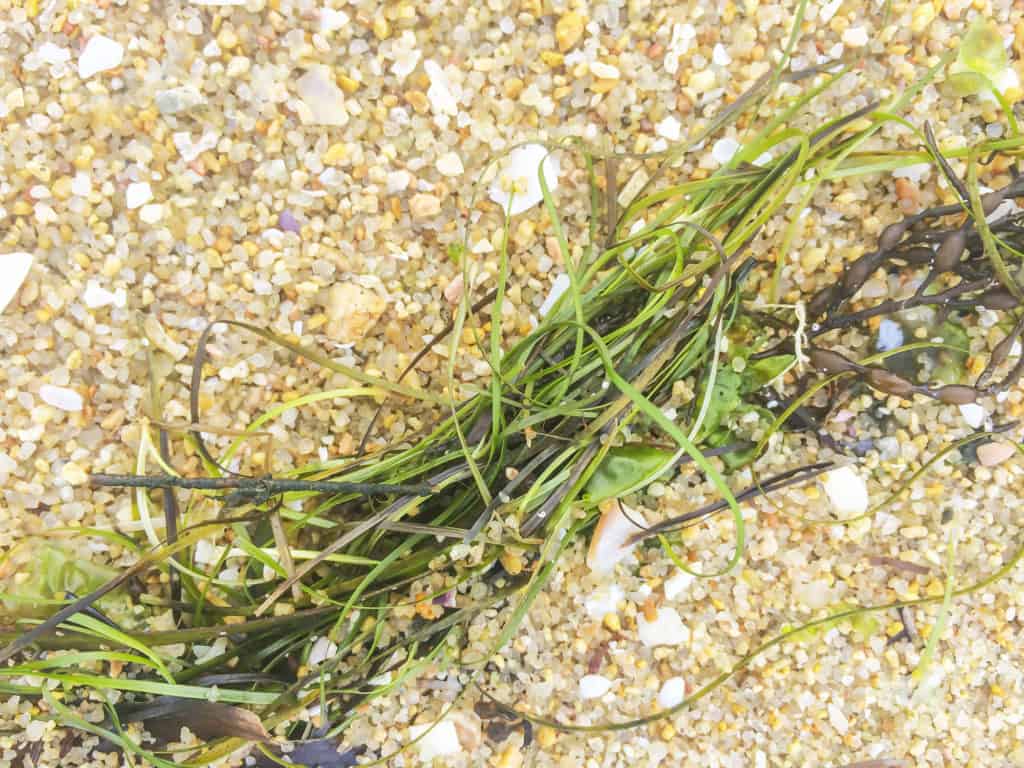
As one of the oldest aquarium plants, eelgrass is one of the easiest to grow.
Its scientific name is Vallisneria, and it’s also known as tape grass.
It grows in Africa, Europe, North America, and Asia.
Hobbyists love this plant since it grows fast and easily.
It adds to the beauty of your aquarium with the different shapes and sizes of its spiky leaves.
It grows so fast that you need to trim it regularly, so it doesn’t cover the whole aquarium.
If you have a tall tank, however, you can just let it reach the top to give the whole tank a nice look.
Eelgrass uses nitrates for food, so it’s an ideal choice for clearing the water.
It’s so effective that low nitrate content can prevent it from growing or looking healthy.
Eelgrass has a unique feature among other aquarium plants.
It produces seeds and grows flowers that hover on the water.
Flowers produced by both female and male plants meet at the surface of the water, pollinate, and produce seeds.
Eelgrass has many different species like Vallisneria Anhuiensis, Twisted-leaved Vallisneria, Vallisneria Annua, Vallisneria Americana, and Vallisneria Nana.
All of them are good choices for reducing nitrate levels and only differ in appearance and growing conditions.
7. Duckweed
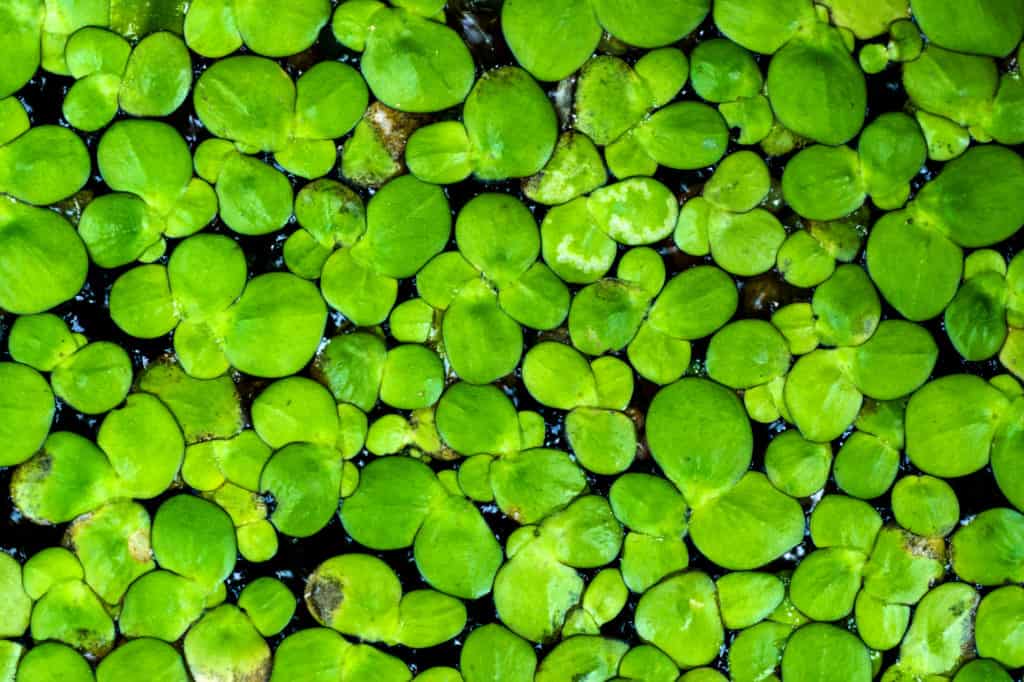
Duckweed is also a great choice when it comes to absorbing nitrates in the water.
It’s a floating plant which grows very quickly and thrives in clean water.
It’s a staple plant among both beginner and seasoned aquarists because it’s easy to care for and works as a perfect natural water filter.
Besides using up nitrates, it cleans the tank of algae to maintain a clear surface cover for your fish.
It serves many purposes like cleaning water, acting as a shade for big or small fish, providing spawning spaces, and even serving as food for fish.
Fish like goldfish, plecos, cichlids, tilapia, and butterfly Splitfins love eating duckweed as their primary food source.
That’s not necessarily bad because you can use this fast-growing plant as a food source for your fish and prevent it from taking over the tank.
The fine roots dangle below the small, oval-shaped leaves which float on the surface of the water.
It’s also one of the most beautiful aquatic plants with its unique-shaped flowers that make it resemble a tiny lily pad.
Since the plant propagates quickly and is very difficult to kill, it can cover the tank’s whole surface.
Make sure it doesn’t deprive the tank of light, oxygen, and nutrients.
Despite these disadvantages, it’s generally one of the most useful aquarium plants that’s aesthetically appealing, too.
That’s why the aquatic community just loves it!
8. Water Sprite
![]()
Water sprite or Ceratopteris thalictroides is another useful, low-maintenance, and beautiful plant that removes nitrates and ammonia from the tank.
Its fast-growing leaves quickly absorb all harmful chemicals from the water, acting like a highly efficient water filter.
Also known as Indian Water Fern, this plant can either grow in substrate or float on the surface.
Its distinctively large size can add a lot of green to different parts of the tank.
If you plant it, water sprites can fill the holes in the mid-ground or background.
If you use it as a floating plant, it can act as a green cover for the water surface and provide shady areas for fish.
Since water sprites thrive under different light levels and water conditions, it grows very fast.
So, if you don’t want it to grow like a weed, you should trim the excess growth carefully without tearing the leaves.
Plus, its fast growth calls for a big tank to give it enough room to thrive.
Generally speaking, bigger is always better.
Some snails, goldfish, and cichlids can be threats to water sprites since they love eating them.
However, it’s a friendly and exciting space for fish to cover under it.
9. Frogbit

Frogbit is another fast-growing aquarium plant that feeds on nitrate and ammonia to clean the water.
It looks like duckweed but has bigger leaves. With a maximum height of 20 inches, it spreads all over the water surface.
Its rounded floating leaves create a perfect hiding place for fish as with most nitrate-reducing plants.
Although it’s a low-maintenance plant that grows really fast, it doesn’t like too much water flow.
If there’s water on top of its leaves, it’ll rot, so it’s essential to keep the top of the plant dry.
Remember to change the water regularly because keeping the plant in stale water leads to its decay.
When you change the water, make sure to add fertilizer to avoid depriving the plant of nutrients.
Under the right conditions, the mature plant produces white flowers with yellow centers.
This gives a stunningly beautiful look to your fish tank as well as a large surface area to reduce nitrates.
10. Water Lettuce
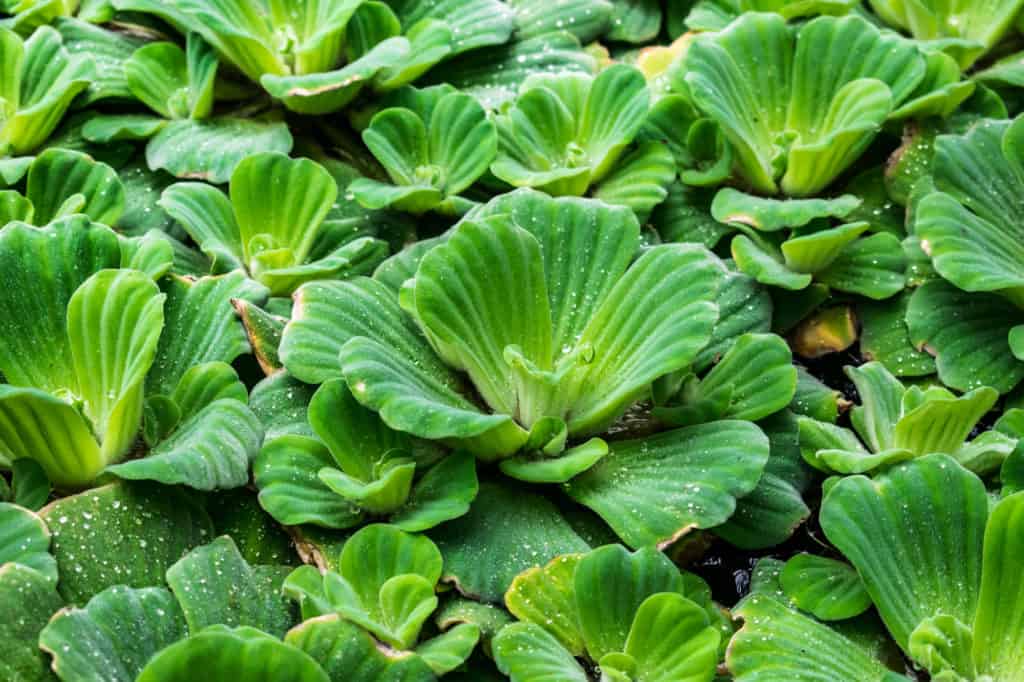
Also called water cabbage or Nile cabbage, water lettuce looks exactly as it sounds: a big head of cabbage or lettuce blooming like a large flower.
It has long green leaves which make it one of the biggest nitrates-treating aquarium plants.
Being a floating plant, it gets all the nutrients from the water and is a nitrate-lover.
It’s so effective in absorbing nitrates from water that it has been used in treating sewage waste.
It’s a great natural filter due to its size, but it can’t fit into small tanks and blocks the light for other plants.
However, it doesn’t need much maintenance.
It’s mostly care-free and adapts itself to different conditions, but its leaves shouldn’t be wet.
Also, fish tend to nibble at the roots, which could kill the plant.
To keep the fish off the plant, you can put the water lettuce in a floating basket.
It thrives in warm weather and during summertime.
In the winter, it needs ample light from the sun or fluorescent lamps.
Other Ways to Reduce Nitrate

Adding nitrate-absorbing plants to the fish tank is one of the most effective ways to keep the water clean and keep off algae.
However, it’s best to follow a combination of nitrate-reducing solutions to ensure the nitrate content is in check.
Here are some other techniques that help reduce nitrate levels.
1. Change the Water Regularly
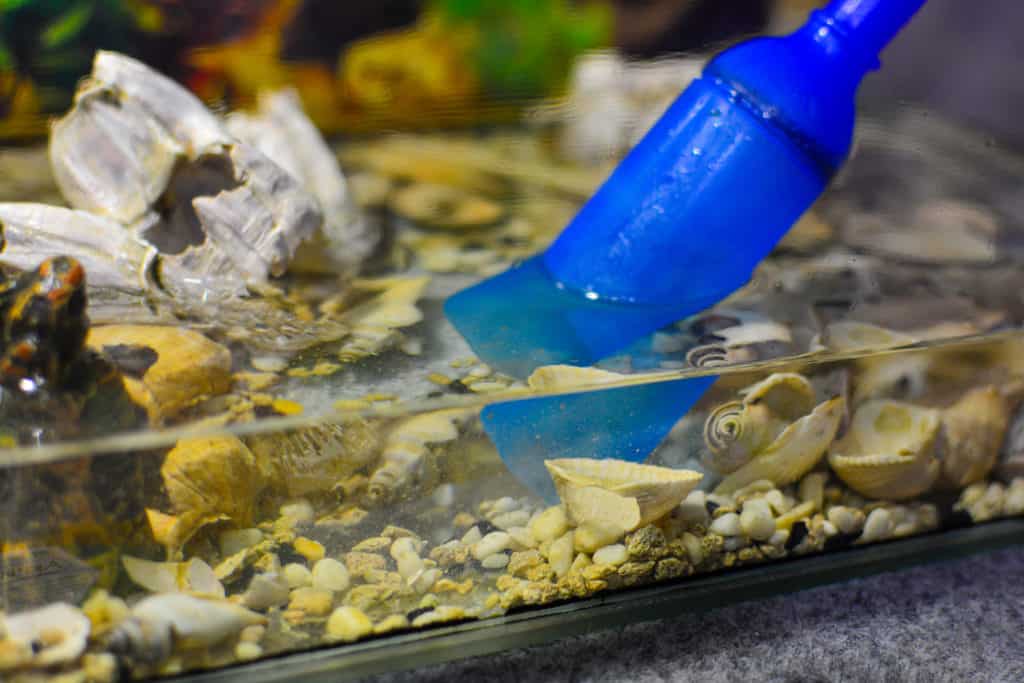
Do water changes at least once a week.
If the nitrate levels are higher, you’ll need to do it more often.
If your tap water contains too much nitrate, use a water filter, or buy low-nitrate water suitable for aquariums.
2. Don’t Overfeed the Fish
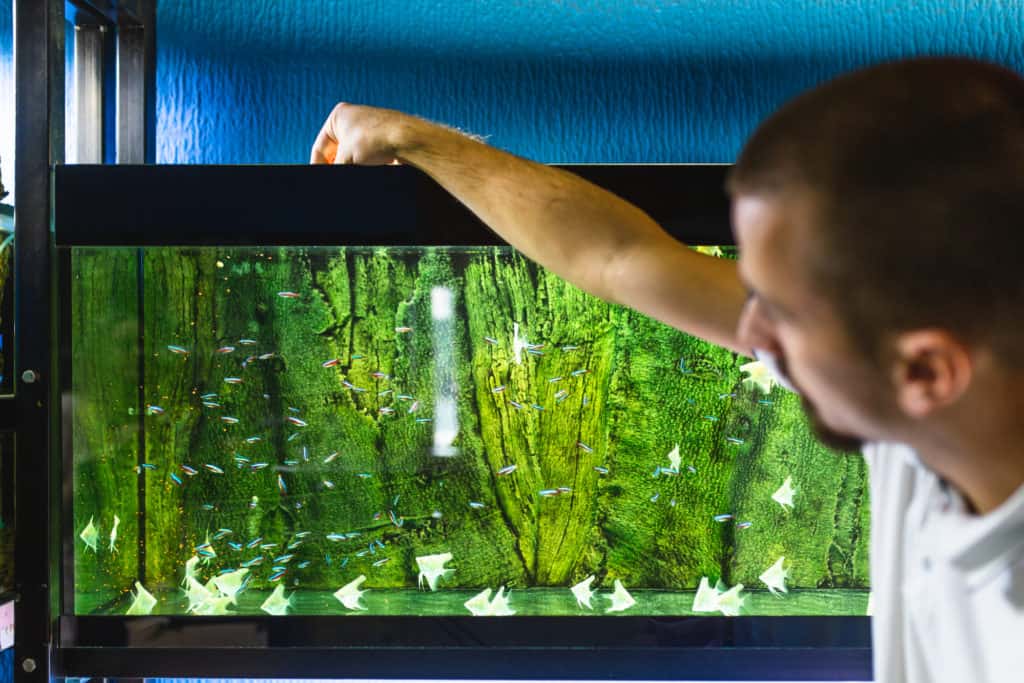
Uneaten food is a significant source of nitrates.
Besides, the more you feed your fish, the more waste they produce.
Fish waste can lead to nitrate build-up in the fish tank.
3. Take Care of Your Plants
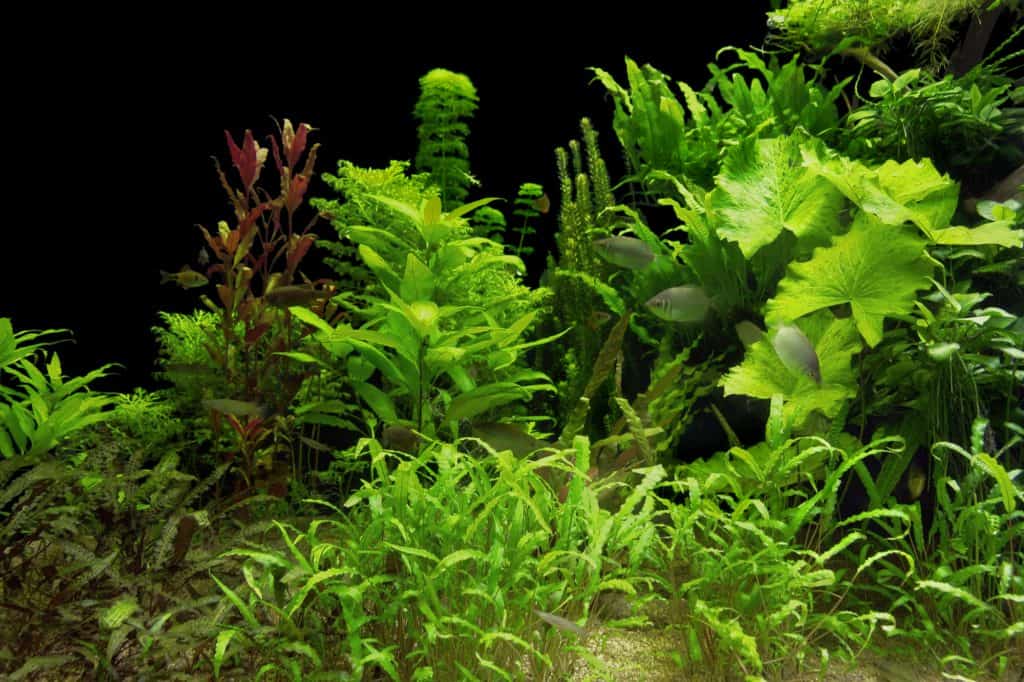
Although plants go a long way in reducing nitrates, their dead or fallen leaves can produce nitrates.
Prune your plants, always look out for dead leaves, and remove them from the tank.
4. Keep the Filter Clean
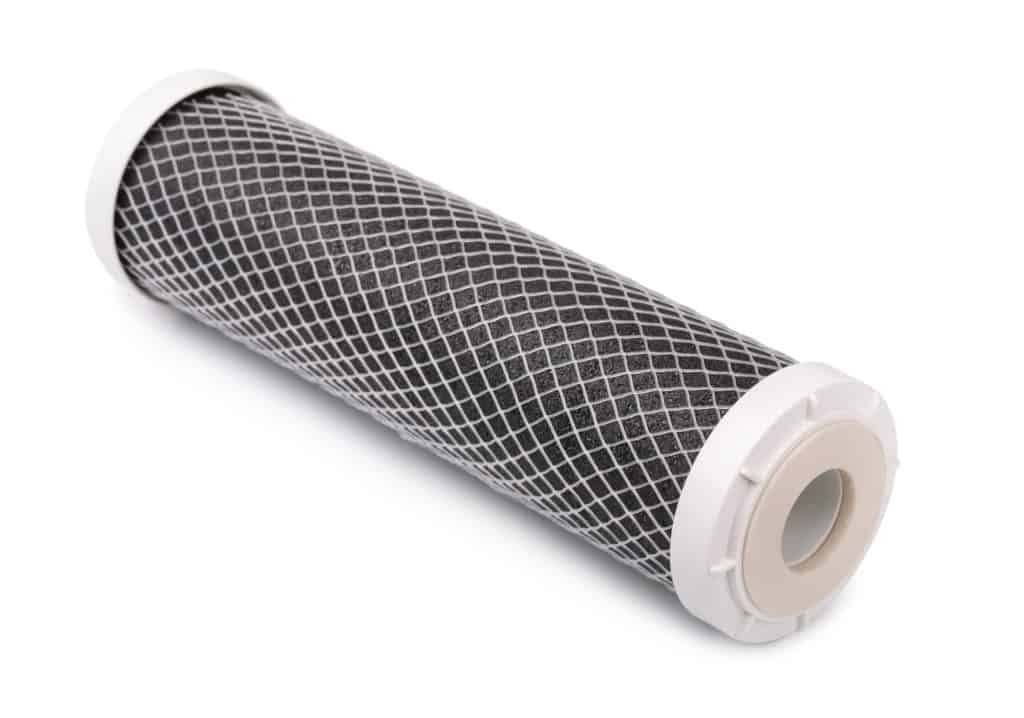
Over time, uneaten bits of food, fish poop, and plant waste can build up in the filters, increasing the nitrate levels.
If cleaning the filter seems like a grueling task, simply use an intake sponge filter.
Cover the filter intake with the sponge to keep waste from entering the filter.
This way, cleaning the filter will be hassle-free by just removing and cleaning the sponge.
5. Don’t Overcrowd the Tank
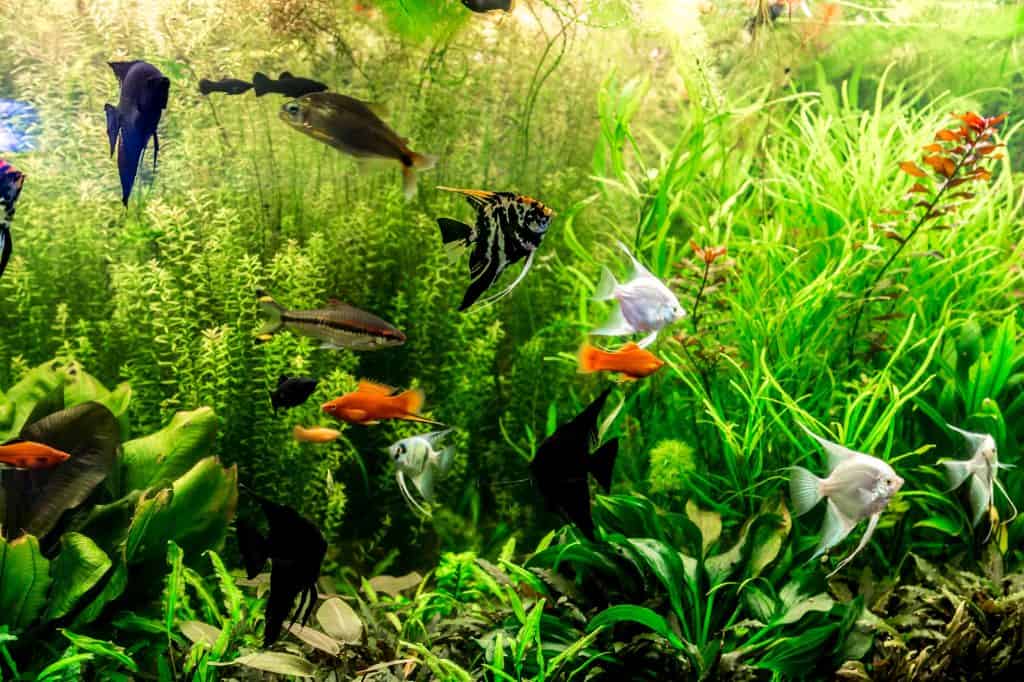
As much as you love to keep lots of cute little fish in your aquarium, having too many fish in the same tank isn’t optimal in terms of nitrate reduction.
You should either keep the number of fish at a minimum or get a larger tank.
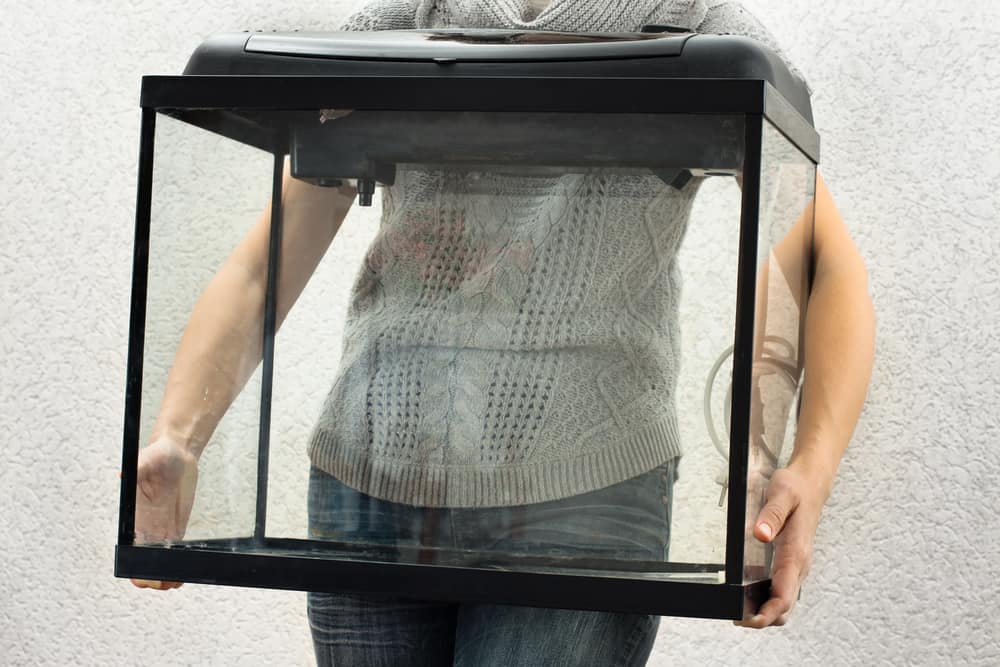
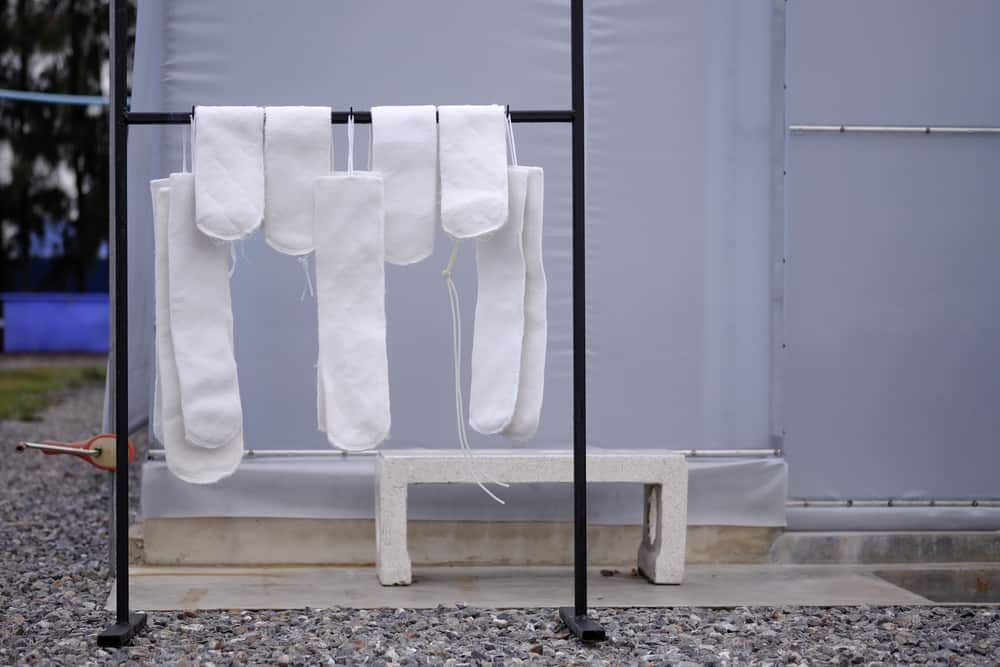
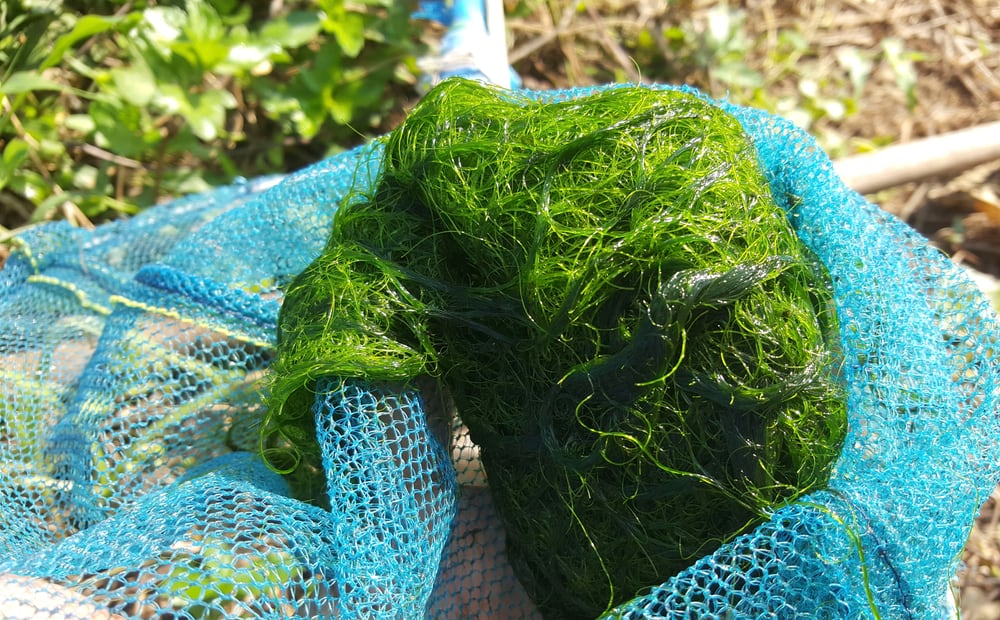
Leave a Reply
You must be logged in to post a comment.